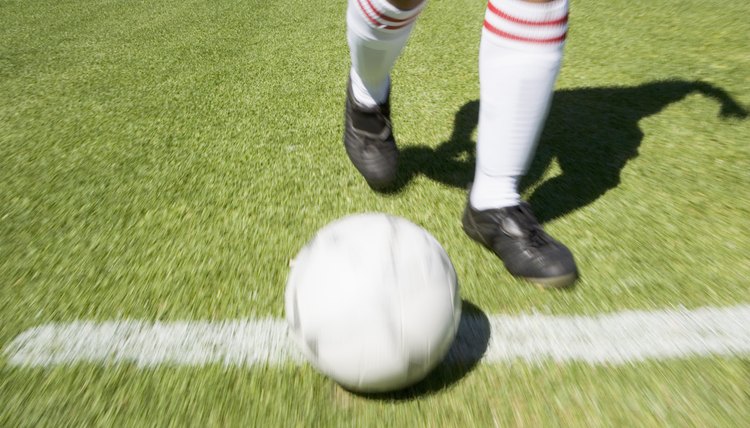What does fact checked mean?
At SportsRec, we strive to deliver objective content that is accurate and up-to-date. Our team periodically reviews articles in order to ensure content quality. The sources cited below consist of evidence from peer-reviewed journals, prominent medical organizations, academic associations, and government data.
- PubMed.gov: Aerobic endurance training improves soccer performance
- PubMed.gov: Aerobic endurance training improves soccer performance
The information contained on this site is for informational purposes only, and should not be used as a substitute for the advice of a professional health care provider. Please check with the appropriate physician regarding health questions and concerns. Although we strive to deliver accurate and up-to-date information, no guarantee to that effect is made.
Interval Training for Soccer

A soccer game is just like 90 minutes of interval training -- running full speed, slowing down when you reach the ball, weaving between defenders, and sudden stops to shoot or change directions, note the former pros at the online site Soccer Training Info. You must train your body to perform according to the demands of a soccer game.
Types
At its simplest, interval training can involve laps around the field, alternating between light jogging and sprints as you reach a corner flag or the midfield line, suggests ExpertFootball.com. If you feel out of breath, slow down on the jogging segments to aid your recovery. Or try shuttle runs -- stand on the goal line facing the field. Sprint to the six-yard line and back, and rest for 10 to 15 seconds. Sprint to the 18-yard line and back. Rest and sprint to the midfield line and back, and rest and repeat the 18-yard shuttle and finally the six-yard shuttle, with rests between all. One rep consists of five of these sprints.
Time Frame
Before engaging in interval training, work for six to eight weeks on aerobic exercises, such as running, swimming and cycling. Do this three to four days a week for 30 minutes, recommends the head men's coach at Skidmore College in Vermont, in the book "The Soccer Coaching Bible." During the early stages of interval training, have a rest-to-sprinting ratio of 3:1 or 4:1 to protect players from injury. Decrease the rest ratio to 1:1 as the players achieve higher levels of fitness.
Considerations
Resting time is crucial for successful interval training, notes Soccer Training Info. Resting allows your muscles to recover from the intensity of sprinting. Muscles rely on the conversion of glucose to lactic acid to generate energy during exercise. Your rest period enables the muscles to recover from their strain, which can only be sustained briefly, as you inhale oxygen and metabolize more glucose.
Expert Insight
Researchers at the Norwegian University of Science and Technology in Trondheim published findings in 2001 based on 19 male elite junior soccer players. They divided the players into two random groups. One group undertook interval training consisting of four 4-minute runs at 90 percent to 95 percent of maximal heart rate, with a 3-minute rest in between, twice a week for eight weeks. The researchers found increases in the athletes' maximal oxygen uptake. The players covered 20 percent more ground during a match compared to the control group. The researchers concluded that interval training enhanced work intensity, number of sprints and involvements with the ball during games.
Significance
While soccer requires technical and tactical skills, physical resources such as endurance, strength and speed play crucial roles, notes Jan Helgerud and colleagues, who conducted the Norwegian study. Interval training may also prove crucial -- Helgerud's literature review discovered studies finding that the rank of the best four teams in the Hungarian premier soccer division matched their ranking on average maximal oxygen intake. Similar results come from a study of teams in the Norwegian elite division.
Explore In Depth
References
Writer Bio
An award-winning writer and editor, Rogue Parrish has worked at the Washington Post, the Baltimore Sun and at newspapers from England to Alaska. This world adventurer and travel book author, who graduates summa cum laude in journalism from the University of Maryland, specializes in travel and food -- as well as sports and fitness. She's also a property manager and writes on DIY projects.
